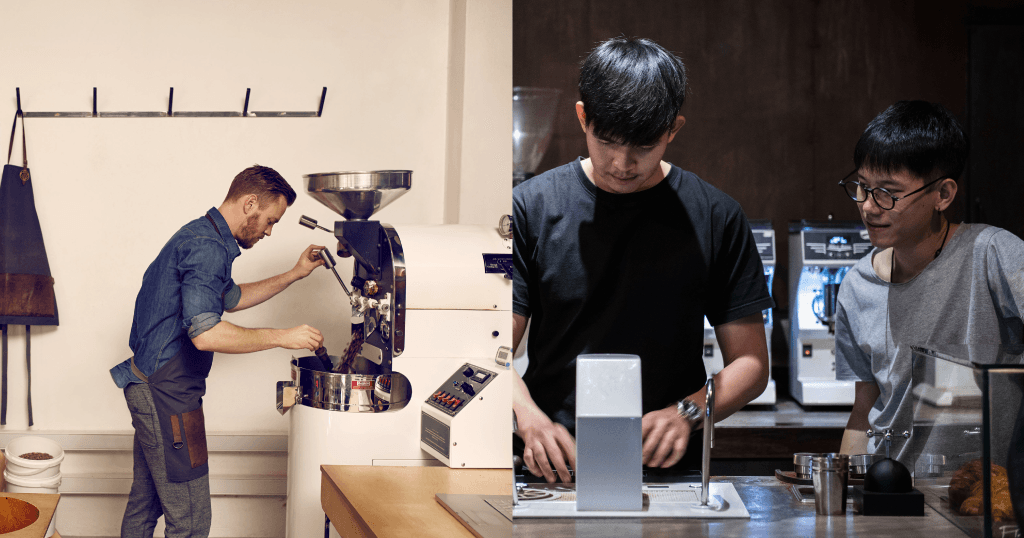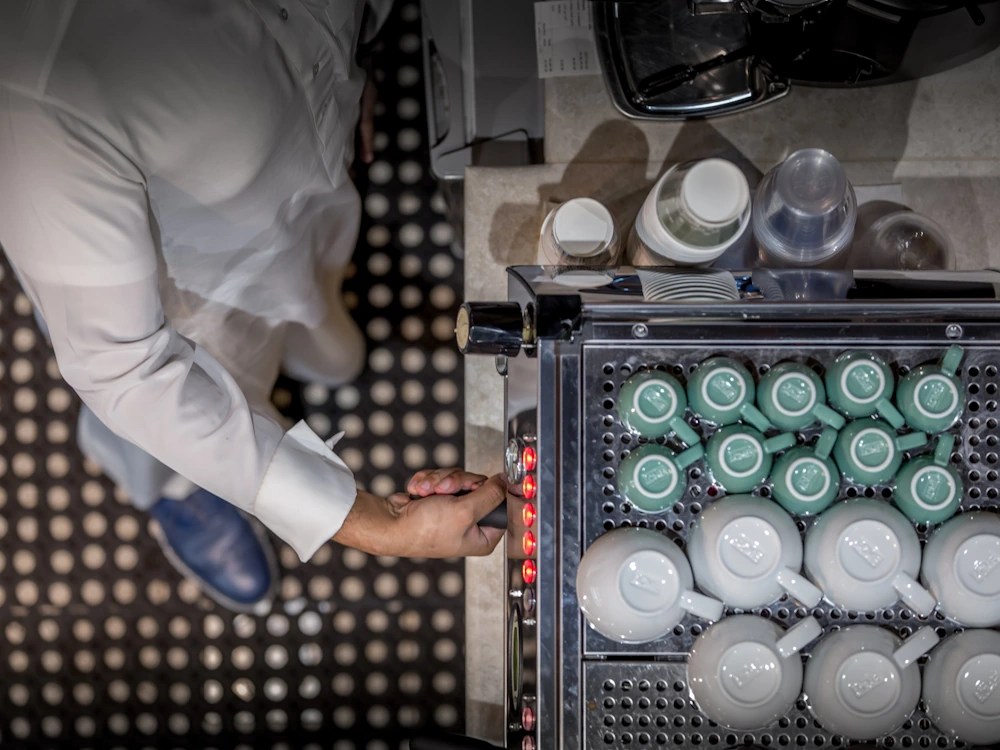
The specialty coffee market has grown exponentially throughout the last decade, bringing about significant changes in consumer preferences, company culture, and market trends.
In an industry once defined by its passion and enthusiasm, roasters are increasingly forced to adopt a pragmatic approach to compete, differentiating themselves from other quality-driven brands to offer something new.
Only two months into 2025, the industry seems poised to enter a new era. As arabica futures consistently hover around US $4.3/lb, the market becomes less predictable for roasters and traders.
I spoke to Rachel Apple, a coffee consultant, and Marcus Goucher, the production manager at Bridge Coffee Roasters, to learn more about the industry’s challenges and opportunities this year.
You may also like our article on what will change for roasters in 2025.

Roasters face an increasingly challenging market
The beginning of the specialty coffee movement was marked by passion-driven entrepreneurs who focused on leaner supply chains, higher-quality lots, and consumer education. But key events over the last five or so years have created new challenges, reshifting this focus onto operational efficiency.
Covid-19 had a huge impact at every level of the supply chain, forcing roasters to adapt to a rapidly changing environment. Many invested in their e-commerce sales, offering subscription services and equipment distribution to cater to the sharp spike in at-home consumption.
Political instability also contributed to rising global inflation and business costs. The Russia-Ukraine conflict drove global energy and food prices to record highs. Meanwhile, the Israel-Gaza conflict disrupted key international shipping routes, exacerbating the already volatile arabica and robusta futures markets.
By May 2025, robusta prices had reached a 45-year high and have been increasing ever since, reaching a new record in January 2025. Simultaneously, arabica futures hit an all-time high of over US $4.4/lb in early February.
Once anchored by low coffee prices and interest rates, specialty coffee roasters, importers, and exporters now face a more challenging environment. Many small traders have been absorbed by larger players to remain in operation, while roasters shift their buying and pricing strategies to maintain already slim margins.
“I’ve already seen people’s buying decisions impacted by the futures market, marked by consolidation,” says Rachel Apple, a coffee consultant in the US with almost two decades of industry experience. “Because of logistics and political instability, I’ve seen roasters stop sourcing from Ethiopia completely, transitioning to other origins.”
In addition to increasing their retail prices, roasters are opting for more affordable lots and origins like Brazil, offering more blends, and diversifying into ready-to-drink market segments.
“This shift, however, isn’t as simple as turning to robusta or cheaper blends. The narrowing price gap between high-quality robusta and good arabica means cost-saving requires a more nuanced approach,” says Marcus Goucher, the production manager at Bridge Coffee Roasters in Cardiff and London, UK.
“Blends will rise in popularity, not just to cut costs but to balance flavours, address availability challenges, and introduce new sensory profiles while maintaining quality.”
How might the industry adapt in 2025?
Unprecedented arabica prices are reshaping the specialty coffee market, causing panic and uncertainty among buyers who have less oversight of their supply chains. Until Brazil and Vietnam, the world’s two biggest growers, produce good harvests or global demand drops significantly, prices are likely to keep rising.
This will lead to fundamental shifts across the supply chain. Exporters and importers, already under significant pressure, will expand into less mature specialty coffee markets to diversify and safeguard their revenue. Consumers, meanwhile, are likely to brew more coffee at home to offset an increase in retail prices.
Roasters will implement a number of cost-cutting measures to manage leaner supply chains, including direct trade relationships.
“I believe direct trade will grow as cost pressures and sustainability demands increase,” Marcus says. “Platforms like Algrano have shown how transformative direct connections can be for roasters, producers, and consumers alike. They remove intermediaries, offering transparent pricing and ensuring more value reaches producers while strengthening trust across the supply chain.”
By bypassing traditional intermediaries and operating outside of the C market, producers can set their own prices. Roasters, meanwhile, can monitor their entire supply chains more closely, allowing them to manage partnerships more effectively and identify ways to mitigate risk.

How consumer preferences will reshape specialty coffee
Specialty coffee’s emphasis on single origins and micro lots has always attracted younger consumers, who often value traceability, quality, and “exciting” flavour experiences. The most recent 2024 National Coffee Data Trends Specialty Coffee Breakout Report found that 66% of 25 to 39-year-olds in the US drank specialty coffee in the past week. This was more than any other age group in the country, indicating specialty coffee’s mass appeal among millennials in particular.
However, as Gen Z has gained more spending power over the last few years, their influence has led to noticeable shifts in consumer needs and preferences. Black filter coffee, once the drink of choice of specialty coffee connoisseurs, has lost its appeal among younger consumers, who now demand more experiential and indulgent beverages.
More Gen Z coffee drinkers are opting for espresso-based beverages that offer a plethora of customisation options. Rather than being the main focus, coffee becomes a single component, while add-ons like syrups and cold foams provide different flavours and textures.
This fundamentally opposes the “purist” approach that many millennials and Gen X drinkers take to specialty coffee consumption. Instead of choosing batch brew or pour overs that offer a single flavour profile, Gen Z demands options they can tailor to their own taste preferences.
“Younger consumers are driving more personalised experiences in specialty coffee,” Rachel says
The trend towards heavy customisation aligns with Gen Z’s growing social media presence. Visually appealing, unique drinks like Dalgona coffee and brown sugar iced lattes often go viral on platforms like Instagram and TikTok, driving their interest in coffee drinks with additional flavours and ingredients.
Coffee shops need to embrace change
Many specialty coffee shops pride themselves on their rigorous standards for espresso extraction and pour over brewing, which highlights pure coffee flavour. However, as Gen Z gains the highest spending power in the coffee industry, their preferences will force café operators to rethink this more traditional approach.
“Health-conscious consumers are driving interest in additions like adaptogens, protein powders, and antioxidant-rich ingredients, alongside low-calorie, sugar-free, and plant-based choices,” Rachel says.
Interest in wellbeing spiked dramatically after the pandemic, prompting many coffee drinkers to reevaluate their choices. Cold brew and cold coffee drinks emerged as viable options for health-conscious consumers, and they also lend themselves well to customisation.
“Technology will play a key role in helping coffee shops adapt, with smarter machines and apps allowing precise adjustments to brew strength, milk ratios, and even flavour infusions,” Rachel tells me.
While the burgeoning customisation trend seems at odds with specialty coffee’s emphasis on “unadulterated” flavour, it presents shop operators with an opportunity to draw in a younger audience with growing disposable income. To keep in line with the industry’s values, quality will need to be the main priority.
“The challenge will be balancing these evolving preferences with the craftsmanship of specialty coffee, ensuring that quality remains at the heart of every cup,” Rachel adds. “This means sourcing high-quality, natural ingredients that complement the coffee’s flavour while meeting new demand for wellness.”
Staying true to their values of transparency and quality allows coffee shops to embrace customisation and wellness trends without losing the brand authenticity that younger consumers are also seeking.
“Marketing specialty coffee to younger audiences in 2025 will focus on dynamic storytelling, sustainability, and engagement through innovation, like short-form social media content showcasing brewing techniques and origin stories,” Marcus says. “Coffee shops will need to capture the attention of younger consumers to expand specialty coffee’s reach and cultural relevance.”

Anticipating the year ahead
For roaster and coffee shops, 2025 will present challenges and opportunities that reflect key industry changes over the last five years. During this time, specialty coffee has matured and scaled, intensifying competition and making it harder to stand out. Many businesses now face the same obstacles to growth, underscoring the need to stay creative and innovative.
“Specialty coffee faces key challenges this year, including the need to differentiate itself as the price gap with conventional coffee narrows,” Marcus tells me. “Focusing on exceptional quality, sustainability, and brand storytelling will be essential to justify its value.
“The roasting process will become more efficient, sustainable, and innovative while preserving the artistry that defines the craft,” he adds. “As an industry, we’ll need to leverage technology to improve traceability, efficiency, and transparency while strengthening the connection between producers and consumers.
“Specialty coffee has the opportunity to not only survive but thrive by acting as a united, forward-thinking community.”
Looking ahead, roasters and traders will need to balance quality with cost efficiency, retain customers while diversifying their client base, and innovate without losing their core values. By doing so, they will be better equipped to navigate what is likely to be a turbulent year for many.
“I hope that specialty coffee consumption continues to grow in 2025, that we’re creating a cultural shift that brings more people into the fold,” Rachel concludes.

Once defined by its passion and idealism, specialty coffee has evolved into a more pragmatic industry. This year is already shaping up as one that will propel the market further in this direction.
Record coffee prices and heightened market competition will force roasters, coffee shops, and traders to rethink the strategies that once underpinned their business success. Ultimately, a willingness to embrace change will allow them to navigate the challenges ahead.
Enjoyed this? Then read our article on why coffee acquisitions will continue in 2025.
Perfect Daily Grind
Want to read more articles like this? Sign up for our newsletter!
Escape from it all while still enjoying the comforts of home. Discover Expedia's array of vacation rental options—from cozy city apartments to picturesque beachfront villas.
Source link
